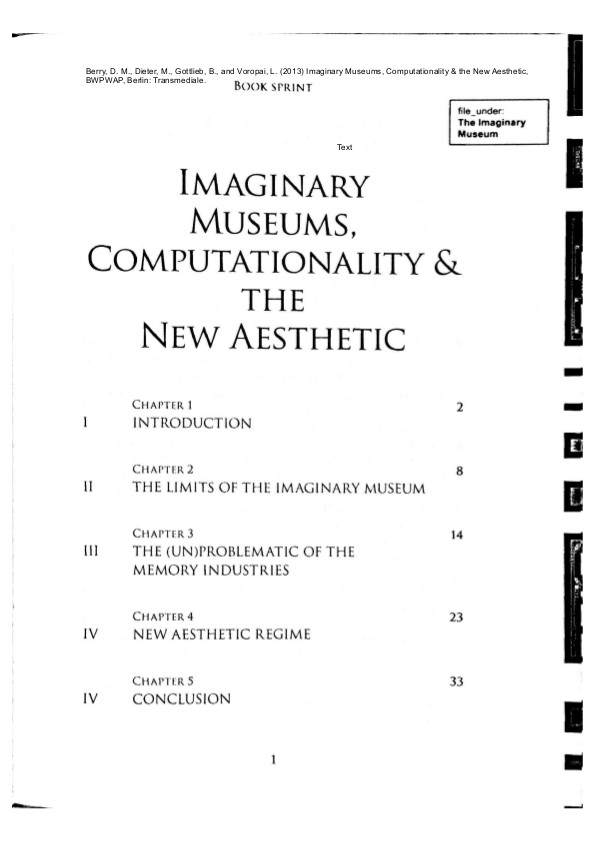Bonnie Mak: How the Page Matters (2011)
Filed under book | Tags: · book, codex, e-book, image, library, paratext, print, reading, text, typography

“From handwritten texts to online books, the page has been a standard interface for transmitting knowledge for over two millennia. It is also a dynamic device, readily transformed to suit the needs of contemporary readers. In How the Page Matters, Bonnie Mak explores how changing technology has affected the reception of visual and written information.
Mak examines the fifteenth-century Latin text Controversia de nobilitate in three forms: as a manuscript, a printed work, and a digital edition. Transcending boundaries of time and language, How the Page Matters connects technology with tradition using innovative new media theories. While historicizing contemporary digital culture and asking how on-screen combinations of image and text affect the way conveyed information is understood, Mak’s elegant analysis proves both the timeliness of studying interface design and the persistence of the page as a communication mechanism.”
Publisher University of Toronto Press, 2011
Studies in Book and Print Culture series
ISBN 080209760X, 9780802097606
ix+129 pages
Reviews: Martha W. Driver (Speculum, 2013), Martin G. Eisner (Renaissance Quarterly, 2013), Brett A. Hudson (Papers of the Bibliographical Society of America, 2014), Julie Holcomb (Information & Culture, 2012).
Interview with author: Gretchen E. Henderson (Ploughshares Literary Magazine, 2013).
PDF (scan; updated on 2023-6-5)
PDF (updated on 2020-10-7)
Erwin Panofsky: Perspective as Symbolic Form (1927–) [DE, ES, EN]
Filed under book | Tags: · art, art history, art theory, geometry, image, optics, perspective, philosophy, theology

“Erwin Panofsky’s Perspective as Symbolic Form is one of the great works of modern intellectual history, the legendary text that has dominated all art-historical and philosophical discussions on the topic of perspective in the last century. This unrivaled example of Panofsky’s early method places him within broader developments in theories of knowledge and cultural change. Here, drawing on a massive body of learning that ranges over ancient philosophy, theology, science, and optics as well as the history of art, Panofsky produces a type of ‘archaeology’ of Western representation that far surpasses the usual scope of art historical studies.
Perspective in Panofsky’s hands becomes a central component of a Western “will to form,” the expression of a schema linking the social, cognitive, psychological, and especially technical practices of a given culture into harmonious and integrated wholes. He demonstrates how the perceptual schema of each historical culture or epoch is unique and how each gives rise to a different but equally full vision of the world. Panofsky articulates these distinct spatial systems, explicating their particular coherence and compatibility with the modes of knowledge, belief, and exchange that characterized the cultures in which they arose. Our own modernity, Panofsky shows, is inseparable from its peculiarly mathematical expression of the concept of the infinite, within a space that is both continuous and homogenous.”
First published in Vorträge der Bibliothek Warburg 1924-1925, Leipzig/Berlin: Teubner, 1927, pp 258-330.
Reprinted in Panofsky, Aufsätze zu Grundfragen der Kunstwissenschaft, eds. Hariolf Oberer and Egon Verheyen, 1974; Berlin 1992, pp 99-167.
English edition
Translated by Christopher S. Wood
Publisher Zone Books, New York, 1991
ISBN 0942299523, 9780942299526
196 pages
Review: E.H. Gombrich (NY Review of Books 1997).
Publisher (EN)
Die Perspektive als ‘symbolische Form’ (German, 1927/1980)
La perspectiva como forma simbolica (Spanish, trans. Virginia Careaga, 1973/2003)
Perspective as Symbolic Form (English, trans. Christopher S. Wood, 1991, no OCR)
D. M. Berry, M. Dieter, B. Gottlieb, L. Voropai: Imaginary Museums, Computationality & the New Aesthetic (2013)
Filed under sprint book | Tags: · aesthetics, computing, museum, net culture, new aesthetic

“This text was produced in a four-day long process of collaborative writing, a so called book sprint, facilitated by Adam Hyde through the Booktype software and featuring writers David M. Berry, Michael Dieter, Baruch Gottlieb and Lioudmila Voropai. The instructions were to write an essay on the relationship between the netculture meme, The New Aesthetic and The Imaginary Museum, as an art world meme. Following this intense and extremely creative writing process, a work of approximately 12,000 words was produced as a contribution to the file_under: The Imaginary Museum informing transmediale 2013.” (Source)
Self-published in Berlin, January 2013
41 pages
via anonymous
PDF (no OCR)
Comment (0)
